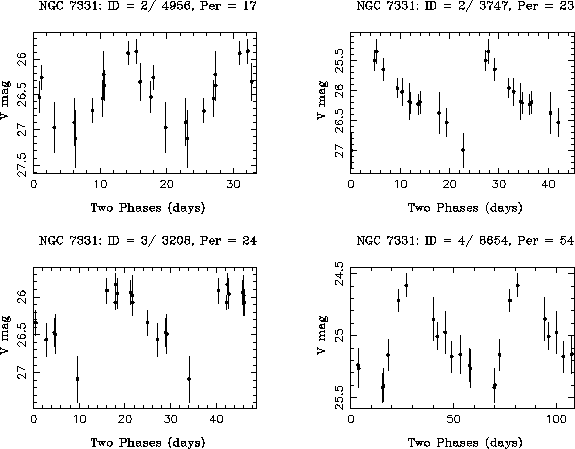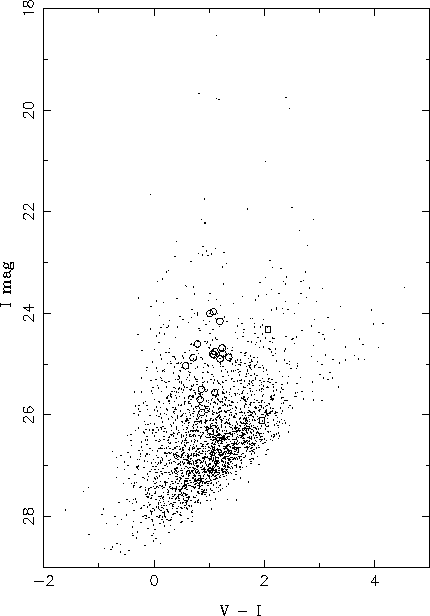




Next: Extragalactic Cepheid
Distances
Up: HST and the
Previous: Hubble Space Telescope
Science with the Hubble Space Telescope -- II
Book Editors: P. Benvenuti, F. D. Macchetto, and E. J. Schreier
Electronic Editor: H. Payne
Shaun Hughes
Royal Greenwich Observatory, Madingley Road, Cambridge CB3 0EZ, UK
Mingsheng Han, John Hoessel
University of Wisconsin, Madison, Wisconsin 53706, USA
Abstract:
NGC 7331 has been observed by HST's WFPC2 as part of the Extragalactic
Distance Scale Key Project. Multi-epoch exposures in F555W ( )
and F814W (
)
and F814W ( ) were obtained, with the final epochs taken in August
1995. A total of 19 Cepheids have been found, with periods between
10 and 64 days. The I, V-I color-magnitude diagram shows all but 2 of the
Cepheids lie within the instability strip, and their period-luminosity
relations in V and I are consistent with those for Cepheids in the LMC.
) were obtained, with the final epochs taken in August
1995. A total of 19 Cepheids have been found, with periods between
10 and 64 days. The I, V-I color-magnitude diagram shows all but 2 of the
Cepheids lie within the instability strip, and their period-luminosity
relations in V and I are consistent with those for Cepheids in the LMC.
Keywords: galaxies, cepheids, distance scale
NGC 7331 is one of 18 galaxies chosen by the HST Extragalactic
Distance Scale Key Project to calibrate secondary distance
estimators, using HST to obtain an accurate distance via
Cepheid variables, with the ultimate goal of using these to measure
H to an external accuracy of 10%. NGC 7331 is in the constellation
of Pegasus, at position
to an external accuracy of 10%. NGC 7331 is in the constellation
of Pegasus, at position  22 37 05.2,
22 37 05.2,  +34 25 10
(J2000). It is an early type
spiral classified as Sb(rs)I-II in the Revised Shapley Ames scheme
by Sandage & Bedke (1985), and given a Hubble type T = 3 by
de Vaucouleurs et al. (1991) with an inclination of 71
+34 25 10
(J2000). It is an early type
spiral classified as Sb(rs)I-II in the Revised Shapley Ames scheme
by Sandage & Bedke (1985), and given a Hubble type T = 3 by
de Vaucouleurs et al. (1991) with an inclination of 71 (Huchtmeier & Richter 1989), and was chosen as one of the calibrators
for the luminosity-line width (aka Tully-Fisher) relation.
(Huchtmeier & Richter 1989), and was chosen as one of the calibrators
for the luminosity-line width (aka Tully-Fisher) relation.
The WFPC2 field lies 3.5 arcmin north
of the galaxy's nucleus, along the major axis. Variable
stars were detected from 15 epochs of F555W cosmic-ray split exposures,
and their colors were measured from 4 epochs of F814W exposures, over
the interval of 1994 June 18 to 1995 August 17. All of these epochs
are thus taken after the decrease in
WFPC2's operating temperature (which occurred on 1994 April 23).
As such, no correction for a charge transfer effect has been
attempted, as it adds a maximum of 0.01 magnitudes rms uncertainty,
and as most of our WFPC2 field has a high background, any charge
transfer effect is likely to be even smaller than this.
The photometry was derived independently by SH and MH,
each using programs based on DoPHOT (Schechter, Mateo & Saha 1993,
Saha et al. 1994) and DAOPHOT/ALLFRAME (Stetson 1994),
respectively, in a
similar way as described in detail for M100 by Hill et al. (1996).
IRAF routines were used for all image arithmetic.
Similar methods as described by Ferrarese et al. (1996) (for M100)
were also used to detect Cepheids in NGC 7331. Master lists of objects
obtained from combined medianed images of all epochs gave a total of
6720, 7215, 8193, and 9026 objects for chips 1--4, respectively.
A 1.5 sigma cut, with a minimum of 10 or more epochs was applied,
resulting in 179, 313, 229 and 299 variables for chips 1--4. The
lightcurves of each of these were then searched for those that are
periodic with periods between 10 and 80 days, rejecting any that were
obviously crowded or near a saturated star. The number of good
Cepheid candidates (i.e., those with regular, Cepheid-like lightcurves)
obtained for each chip is 0, 11, 3, and 5, and a sample are shown
in Figure 1.

Figure: Phased lightcurves for 4 of the Cepheids in NGC 7331.
Corrections to the intensity averaged I mags were made, as described in
Ferrarese et al. (1996), to account for the sparser sampling of the I data as
compared to the V data.
The reasons for using two independent photometry programs to search for
Cepheids is to provide a check on any systematic errors that may be
present in deriving photometry from WFPC2 images. The Cepheid
lists and periods were obtained independently from each photometry set
and are consistent with each other. We are still in the process of
defining an absolute calibration for the photometry and defer to a
later publication the presentation of the distance to NGC 7331 (Hughes
et al. 1996). But we can show that the Cepheids
found have period and color properties that are consistent with LMC Cepheids.
The mean magnitudes from all epochs has been used to produce the deep
I vs V-I color-magnitude diagram in Figure 2.

Figure: I vs V-I CMD for chips 2--4
of the WFPC2 field (no Cepheids were found on the PC chip).
For clarity, only every 10th star is plotted.
Open circles are the Cepheids. Those outside the instability strip
are marked by open squares.
This shows that most of our Cepheids lie within the classic Cepheid
instability strip. The two that lie outside the edge will
not be used in deriving distance moduli, as they are likely to be
either contaminated by a companion, or else have unusual amounts of
reddening.
The Period-Luminosity relations in V and I are shown in
Figure 3.

Figure: Period-Luminosity relations in V (top panel) and I
(bottom panel). Solid circles are NGC 7331 Cepheids found with HST,
open circles are LMC Cepheids from Madore (1985). The straight line is a
least squares fit, with slope
set independently by the LMC Cepheids only, and the offset by the
NGC 7331 Cepheids. The variables outside the instability
strip and excluded from the fit are indicated by `R'
(numbers are the V-I colors).
Also plotted are the LMC Cepheids that have periods within the range
of the NGC 7331 Cepheids, with their magnitudes shifted to
minimize the least squares fit. All of the LMC
Cepheids are within the above color limits. The two empirical PL
relations for the LMC and NGC 7331 are very alike in both V and I,
with no obvious differences
in slope. Hence, we can be confident that the relative distance modulus between
the LMC and NGC 7331 will be accurate, once the DoPHOT/ALLFRAME
photometric zeropoint calibration has been derived.
Acknowledgments:
Any project as ambitious as the Extragalactic Distance Scale requires
a lot of work to produce the proposals, the development of the software,
and the careful analysis and calibration of the photometry and lightcurves,
and fitting procedures. Hence this
work would not be possible without the efforts of the rest of the H team: Wendy Freedman, Jeremy Mould, Robert Kennicutt Jr., Sandra Faber,
Laura Ferrarese, Holland Ford, John Graham, James Gunn, Paul Harding,
Bob Hill, John Huchra, Garth Illingworth, Dan Kelson, Barry Madore,
Randy Phelps, Abhijit Saha, Shoko Sakai, Nancy Silbermann, Peter Stetson, and
Anne Turner.
We are also indebted to the very able support provided by the staff at STScI,
in particular Bob Williams and Doug Van Orsow.
Support for this work was provided by NASA through grant number
2227-87A from STScI which is operated by AURA, Inc. under NASA Contract
NAS5-26555.
team: Wendy Freedman, Jeremy Mould, Robert Kennicutt Jr., Sandra Faber,
Laura Ferrarese, Holland Ford, John Graham, James Gunn, Paul Harding,
Bob Hill, John Huchra, Garth Illingworth, Dan Kelson, Barry Madore,
Randy Phelps, Abhijit Saha, Shoko Sakai, Nancy Silbermann, Peter Stetson, and
Anne Turner.
We are also indebted to the very able support provided by the staff at STScI,
in particular Bob Williams and Doug Van Orsow.
Support for this work was provided by NASA through grant number
2227-87A from STScI which is operated by AURA, Inc. under NASA Contract
NAS5-26555.
References:
de Vaucouleurs, G. et al. 1991, Third Reference
Catalogue of Bright Galaxies
Ferrarese, L. et al. 1996, ApJ, submitted
Hill, R. et al. 1996, ApJ, submitted
Huchtmeier, W.K. & Richter, O.-G. 1989, A General Catalog
of HI Observations of Galaxies, New York: Springer
Hughes, S.M. et al. 1996, in preparation
Madore, B.F. 1985, in IAU Coll. 82, Cepheids, Theory and
Observations, ed. B.F.Madore, Cambridge: Cambridge University Press, p. 166
Sandage, A. & Bedke, J. 1985, AJ, 90, 1992
Schechter, P.L., Mateo, M., & Saha, A. 1993, PASP, 105, 1342
Stetson, P.B. 1994, PASP, 106, 250





Next: Extragalactic Cepheid
Distances
Up: HST and the
Previous: Hubble Space Telescope
payne@stsci.edu
 to an external accuracy of 10%. NGC 7331 is in the constellation
of Pegasus, at position
to an external accuracy of 10%. NGC 7331 is in the constellation
of Pegasus, at position  22 37 05.2,
22 37 05.2,  +34 25 10
(J2000). It is an early type
spiral classified as Sb(rs)I-II in the Revised Shapley Ames scheme
by Sandage & Bedke (1985), and given a Hubble type T = 3 by
de Vaucouleurs et al. (1991) with an inclination of 71
+34 25 10
(J2000). It is an early type
spiral classified as Sb(rs)I-II in the Revised Shapley Ames scheme
by Sandage & Bedke (1985), and given a Hubble type T = 3 by
de Vaucouleurs et al. (1991) with an inclination of 71 (Huchtmeier & Richter 1989), and was chosen as one of the calibrators
for the luminosity-line width (aka Tully-Fisher) relation.
(Huchtmeier & Richter 1989), and was chosen as one of the calibrators
for the luminosity-line width (aka Tully-Fisher) relation.
 )
and F814W (
)
and F814W ( ) were obtained, with the final epochs taken in August
1995. A total of 19 Cepheids have been found, with periods between
10 and 64 days. The I, V-I color-magnitude diagram shows all but 2 of the
Cepheids lie within the instability strip, and their period-luminosity
relations in V and I are consistent with those for Cepheids in the LMC.
) were obtained, with the final epochs taken in August
1995. A total of 19 Cepheids have been found, with periods between
10 and 64 days. The I, V-I color-magnitude diagram shows all but 2 of the
Cepheids lie within the instability strip, and their period-luminosity
relations in V and I are consistent with those for Cepheids in the LMC.



 team: Wendy Freedman, Jeremy Mould, Robert Kennicutt Jr., Sandra Faber,
Laura Ferrarese, Holland Ford, John Graham, James Gunn, Paul Harding,
Bob Hill, John Huchra, Garth Illingworth, Dan Kelson, Barry Madore,
Randy Phelps, Abhijit Saha, Shoko Sakai, Nancy Silbermann, Peter Stetson, and
Anne Turner.
We are also indebted to the very able support provided by the staff at STScI,
in particular Bob Williams and Doug Van Orsow.
Support for this work was provided by NASA through grant number
2227-87A from STScI which is operated by AURA, Inc. under NASA Contract
NAS5-26555.
team: Wendy Freedman, Jeremy Mould, Robert Kennicutt Jr., Sandra Faber,
Laura Ferrarese, Holland Ford, John Graham, James Gunn, Paul Harding,
Bob Hill, John Huchra, Garth Illingworth, Dan Kelson, Barry Madore,
Randy Phelps, Abhijit Saha, Shoko Sakai, Nancy Silbermann, Peter Stetson, and
Anne Turner.
We are also indebted to the very able support provided by the staff at STScI,
in particular Bob Williams and Doug Van Orsow.
Support for this work was provided by NASA through grant number
2227-87A from STScI which is operated by AURA, Inc. under NASA Contract
NAS5-26555.